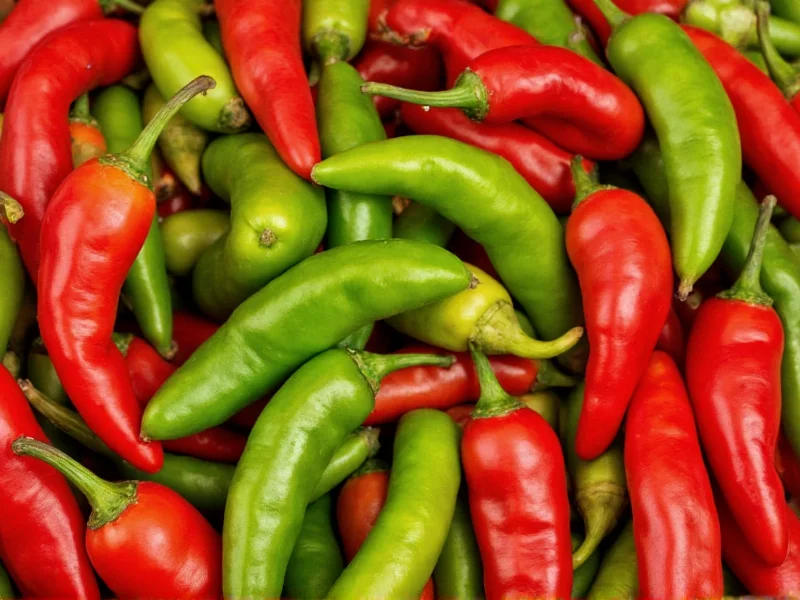Understanding the relationship between fresh peppers and their dried counterparts is essential for anyone exploring global cuisines. The transformation from fresh to dried isn't merely a preservation method—it creates entirely new flavor profiles and culinary applications. This comprehensive guide details the naming conventions, flavor transformations, and culinary uses of peppers in both their fresh and dried forms.
Why Peppers Have Different Names When Dried
The practice of assigning different names to peppers in their fresh versus dried states originated from historical trade practices. As peppers traveled along trade routes, merchants began referring to them by their dried form names since dried peppers were the primary form available for long-distance transport. This created a linguistic separation between fresh local varieties and their dried export versions.
Additionally, the drying process fundamentally changes a pepper's chemical composition. As moisture evaporates, capsaicin concentration increases while certain volatile compounds transform, creating entirely new flavor profiles. A fresh poblano has earthy, grassy notes, while its dried ancho form develops rich raisin-like sweetness with tobacco undertones—justifying the distinct naming convention.
Pepper Nomenclature Reference Guide
Below is a comprehensive reference of common peppers and their dried counterparts. This chart addresses frequent search queries about fresh peppers vs dried peppers names and helps clarify common confusion points in chile pepper naming conventions.
| Fresh Pepper | Dried Name | Flavor Profile Transformation | Common Culinary Uses |
|---|---|---|---|
| Jalapeño | Chipotle (when smoked) or simply "dried jalapeño" | Grassy freshness → Smoky, tobacco-like depth with chocolate notes | Moles, adobo sauces, salsas, marinades |
| Poblano | Ancho | Mild earthiness → Rich, sweet raisin flavor with coffee notes | Mole poblano, stuffing, sauces, stews |
| Guajillo | Guajillo (same name, but technically dried mirasol) | N/A (typically used dried) → Tangy berry flavor with mild heat | Red sauces, marinades, salsas, adobos |
| Chilaca | Pasilla | Leathery freshness → Complex dried fruit, licorice, and berry notes | Moles, sauces, soups, braises |
| Serrano | Seco de Serrano | Bright heat → Concentrated, sharper heat with floral notes | Salsas, hot sauces, pickling |
| Cayenne | Cayenne (same name) | Vibrant heat → Intensified, more complex heat profile | Spice blends, hot sauces, seasoning |
| Bell Pepper | Pimentón (when smoked) or dried bell | Sweet crunch → Concentrated sweetness with possible smokiness | Paprika production, stews, rubs |
Understanding Key Pepper Transformations
Jalapeño to Chipotle: The Smoking Process
When people search for "what are dried jalapeños called," they're often surprised to learn that not all dried jalapeños are chipotles. True chipotles specifically refer to smoked dried jalapeños. The smoking process (traditionally with oak or hickory) imparts the distinctive smoky flavor that defines chipotles. Unsmoked dried jalapeños simply go by "dried jalapeños" but lack the complex flavor profile that makes chipotles so valuable in Mexican cuisine.
Poblano to Ancho: The Sweet Transformation
The poblano to ancho transformation represents one of the most dramatic flavor changes in the pepper world. Fresh poblanos have a mild heat level (1,000-2,000 SHU) with earthy, slightly bitter notes. When dried into anchos, they develop complex sweet notes reminiscent of dried fruit, coffee, and even chocolate, while maintaining moderate heat. This makes anchos essential in traditional mole sauces where their sweetness balances other ingredients.
Guajillo and Mirasol: Clarifying the Confusion
One of the most confusing aspects of chile pepper naming conventions involves guajillo peppers. The fresh form is called mirasol (meaning "facing the sun" in Spanish), but it's rarely sold fresh outside Mexico. Most consumers encounter guajillo only in its dried form, leading many to believe guajillo is the fresh pepper name. Understanding this distinction helps when searching for dried cayenne pepper fresh equivalents or other naming puzzles.
Culinary Applications: When to Use Fresh vs. Dried
Knowing what dried peppers are called isn't just academic—it directly impacts cooking results. Each form brings unique properties to dishes:
- Fresh peppers provide bright acidity, moisture, and immediate heat. They work best in salsas, fresh sauces, and dishes where texture matters.
- Dried peppers offer concentrated flavor, deeper complexity, and easier storage. They excel in slow-cooked dishes, spice blends, and sauces where flavor infusion is key.
Professional chefs often combine both forms in the same dish for layered flavor. For example, a mole might use fresh tomatoes and tomatillos with dried ancho and pasilla peppers to create multidimensional flavor.
Proper Storage of Dried Peppers
Understanding dried bell pepper varieties or other dried chiles means knowing how to preserve their quality. Follow these storage guidelines:
- Store in airtight containers away from light and heat
- Keep in a cool, dark pantry (not the refrigerator, which introduces moisture)
- Whole dried peppers last 6-12 months; ground peppers lose potency after 3-6 months
- Revive stale dried peppers by toasting lightly before use
Properly stored dried peppers maintain their distinctive flavors that make them valuable substitutes when fresh varieties aren't available—addressing common concerns about dried pepper shelf life and quality.
Reconstituting Dried Peppers
Before using most dried peppers (except for grinding into powder), proper reconstitution unlocks their full flavor potential:
- Remove stems and seeds (unless recipe specifies otherwise)
- Toast lightly in a dry skillet for 30-60 seconds per side until fragrant
- Soak in hot water for 15-20 minutes until pliable
- Use in sauces, blends, or as directed in recipes
This process transforms dried peppers back toward their fresh flavor profile while retaining the concentrated essence that makes them valuable culinary ingredients—particularly important when working with expensive varieties like dried ancho chile peppers.











 浙公网安备
33010002000092号
浙公网安备
33010002000092号 浙B2-20120091-4
浙B2-20120091-4